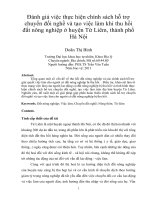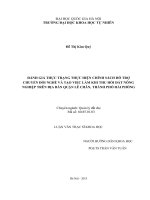Chuyển đổi laplace và laplace ngược bằng Matlab
Bạn đang xem bản rút gọn của tài liệu. Xem và tải ngay bản đầy đủ của tài liệu tại đây (134.81 KB, 3 trang )
Laplace Transforms with MATLAB
a. Calculate the Laplace Transform using Matlab
Calculating the Laplace F(s) transform of a function f(t) is quite simple in Matlab. First
you need to specify that the variable t and s are symbolic ones. This is done with the
command
>> syms t s
Next you define the function f(t). The actual command to calculate the transform is
>> F=laplace(f,t,s)
To make the expression more readable one can use the commands, simplify and pretty.
here is an example for the function f(t),
tt
etetf
22
25.15.325.1)(
−−
++−=
>> syms t s
>> f=-1.25+3.5*t*exp(-2*t)+1.25*exp(-2*t);
>> F=laplace(f,t,s)
F =
-5/4/s+7/2/(s+2)^2+5/4/(s+2)
>> simplify(F)
ans =
(s-5)/s/(s+2)^2
>> pretty(ans)
s - 5
2
s (s + 2)
which corresponds to F(s),
2
)2(
)5(
)(
+
−
=
ss
s
sF
Alternatively, one can write the function f(t) directly as part of the laplace command:
>>
F2=laplace(-1.25+3.5*t*exp(-2*t)+1.25*exp(-2*t))
ESE216 1
b. Inverse Laplace Transform
The command one uses now is ilaplace. One also needs to define the symbols t and s.
Lets calculate the inverse of the previous function F(s),
2
)2(
)5(
)(
+
−
=
ss
s
sF
>> syms t s
>> F=(s-5)/(s*(s+2)^2);
>> ilaplace(F)
ans =
-5/4+(7/2*t+5/4)*exp(-2*t)
>> simplify(ans)
ans =
-5/4+7/2*t*exp(-2*t)+5/4*exp(-2*t)
>> pretty(ans)
- 5/4 + 7/2 t exp(-2 t) + 5/4 exp(-2 t)
Which corresponds to f(t)
tt
etetf
22
25.15.325.1)(
−−
++−=
Alternatively one can write
>> ilaplace((s-5)/(s*(s+2)^2))
Here is another example.
)54(
)2(10
)(
2
++
+
=
sss
s
sF
>> F=10*(s+2)/(s*(s^2+4*s+5));
>> ilaplace(F)
ans =
-4*exp(-2*t)*cos(t)+2*exp(-2*t)*sin(t)+4
Which gives f(t),
)()]sin(2)cos(44[)(
22
tutetetf
tt −−
+−=
making use of the trigonometric relationship,
)/(tan
)cos()sin()cos(
)sin()cos()sin(
1
22
xy
yxR
with
Ryx
and
Ryx
−
=
+=
+=−
+
=+
β
βααα
β
α
α
α
One can also write that f(t)
)()]4.153cos(47.44[
2
tute
ot
−+=
−
ESE216 2
Matlab often gives the inverse Laplace Transform in terms of sinhx and coshx. Using the
following definition one can rewrite the hyperbolic expression as a function of
exponentials:
2
)sinh(
xx
ee
x
−
+
=
2
)cosh(
xx
ee
s
−
−
=
Also, you may find the “Heaviside(t) function which corresponds to the unit step function
u(t): thus the function H(t) = heaviside(t) =0 for t<0 and H(t) = heaviside(t)=1 for t>0.
As an example, suppose that Matlab gives you the following result for the inverse
Laplace transform:
2 heaviside(t-10) exp(-5/2t+25) sinh(1/2t-5)
This can be re-written, using the definition of the sinh(x) function:
2u(t)
)10(][
])[10(
).10(]
2
[).10(2)(
)10(3)10(2
303202
55.0255.255.0255.2
55.255.0
)10(5.2
−−=
−−=
−−=
−
−=
−−−−
+−+−
+−+−−++−
+−−
−−
tuee
eetu
eetu
ee
etutf
tt
tt
tttt
tt
t
This last expression is closer to what your hand calculations will give you for the invers
Laplace Transform.
ESE216 3









